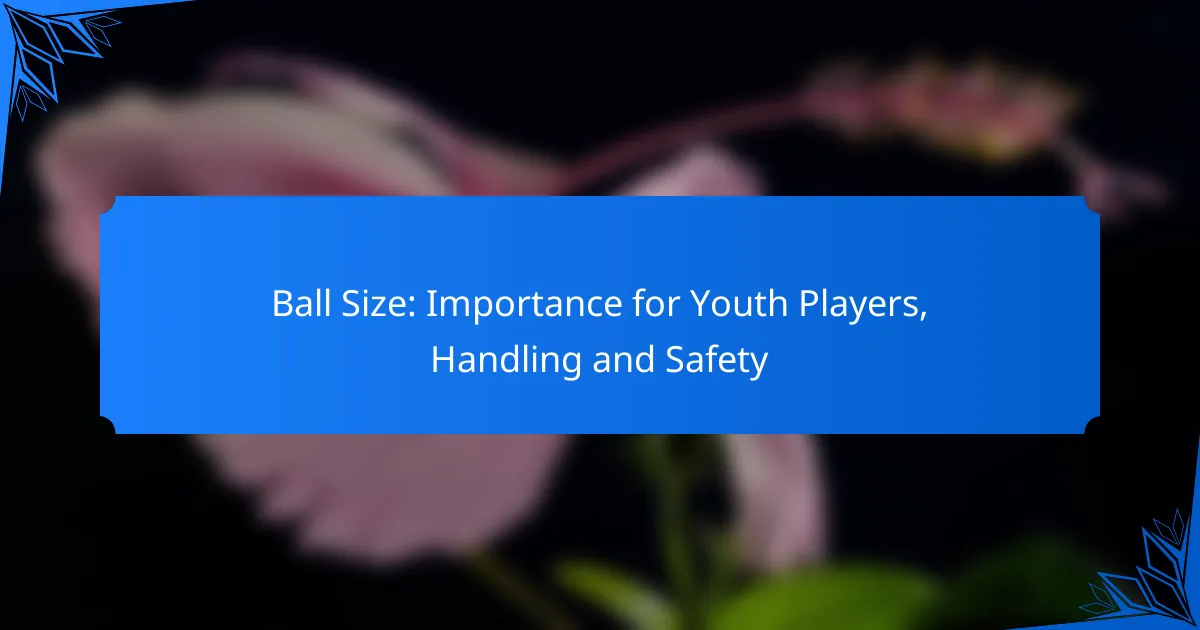The size of the ball is essential for youth players, as it directly influences their skill development and safety during play. Using the appropriate ball size enhances handling techniques, grip, and control, while also minimizing the risk of injury. By adhering to recommended sizes based on age groups, young athletes can improve their performance and enjoy a safer playing experience.

What is the importance of ball size for youth players in the USA?
The size of the ball is crucial for youth players in the USA as it directly affects their ability to develop skills and play safely. Using the appropriate ball size helps young athletes improve their handling techniques and reduces the risk of injury during play.
Enhances skill development
Using the correct ball size allows youth players to practice and refine their skills effectively. For example, smaller balls are often easier for younger players to control, enabling them to focus on dribbling, passing, and shooting techniques. This tailored approach fosters confidence and competence as players progress.
Different age groups should use specific ball sizes according to established guidelines. For instance, a size 3 ball is recommended for children under 8, while sizes 4 and 5 are suitable for older youth players. Adhering to these standards ensures that players are developing their skills in a way that aligns with their physical capabilities.
Promotes safety during play
Choosing the right ball size significantly contributes to safety during youth sports. A ball that is too large or heavy can lead to injuries, such as sprains or strains, especially for younger players with developing bodies. Ensuring that players use appropriately sized balls minimizes the risk of accidents and promotes a safer playing environment.
Coaches and parents should regularly check the equipment to confirm that the balls meet size and weight specifications. This proactive approach not only enhances safety but also encourages a more enjoyable experience for young athletes, allowing them to focus on the game without the fear of injury.

How does ball size affect handling for youth players?
Ball size significantly impacts how youth players handle the ball, influencing their grip, control, and overall technique. Using appropriately sized balls helps young athletes develop essential skills while minimizing the risk of injury.
Improves grip and control
Using the correct ball size enhances a player’s grip and control over the ball. For instance, smaller balls are easier for younger players to hold, allowing them to manipulate the ball more effectively during play. This improved grip leads to better passing, shooting, and dribbling skills.
When selecting a ball, consider the age and size of the players. For example, a size 3 ball is typically recommended for children aged 8 and under, while size 4 is suitable for ages 8 to 12. Ensuring the right size helps players feel more confident and in control.
Facilitates proper technique
Proper ball size is crucial for teaching youth players the correct techniques for handling the ball. When players use a ball that fits their hand size, they can more easily learn to dribble, pass, and shoot with accuracy. This foundational skill development is essential for their long-term success in the sport.
Coaches should emphasize the importance of using the right ball size during practice sessions. For example, using a size 5 ball for players under 12 can hinder their ability to learn proper techniques due to the ball’s weight and size. Prioritizing the correct equipment fosters better learning and skill acquisition.

What are the recommended ball sizes for different age groups?
The recommended ball sizes for youth players vary by age group to ensure proper handling and safety. Using the correct size helps develop skills and prevents injuries during play.
Size 3 for ages 5-8
Size 3 balls are designed for children aged 5 to 8 years. These balls typically have a circumference of about 23-24 inches and weigh around 14-16 ounces. At this stage, players are developing basic coordination and control, making a smaller, lighter ball ideal for their skill level.
When selecting a Size 3 ball, look for options that are soft and lightweight to minimize the risk of injury. Ensure that the ball is made of durable materials that can withstand regular use on various surfaces.
Size 4 for ages 9-12
For players aged 9 to 12 years, a Size 4 ball is recommended. This ball has a circumference of approximately 25-26 inches and weighs about 14-16 ounces. As children grow, their strength and skills improve, making a slightly larger ball more suitable for developing advanced techniques.
Choosing a Size 4 ball should focus on quality and grip. Look for options that provide good control and are suitable for both practice and competitive play. Ensure that the ball meets any local league regulations regarding size and material.

What safety considerations are associated with ball size?
Ball size is crucial for ensuring the safety of youth players. Using appropriately sized balls can significantly reduce the risk of injury and ensure that the impact force is manageable for younger athletes.
Reduces risk of injury
Using the correct ball size helps minimize the risk of injuries such as concussions, fractures, or soft tissue damage. For example, a smaller ball is easier for young players to control, reducing the chances of accidental collisions or falls.
Coaches and parents should ensure that players use balls that match their age and skill level. For instance, youth soccer players typically use size 3 balls until they are around 8 years old, which helps prevent injuries associated with larger, heavier balls.
Ensures appropriate impact force
Ball size directly affects the impact force experienced by players during games and practice. A larger ball can generate more force upon impact, which may be overwhelming for younger players. Using a smaller ball allows for a gentler introduction to the sport.
For instance, in basketball, using a size 5 ball for players aged 9 to 11 helps ensure that the force of the ball is suitable for their developing bodies. This consideration is essential for maintaining safety and promoting a positive experience in youth sports.

How can coaches select the right ball size for their teams?
Coaches can select the right ball size for their teams by considering the players’ age, skill level, and any relevant league regulations. Using the appropriate ball size enhances player development and ensures safety during games and practices.
Assess player age and skill level
When selecting a ball size, it’s crucial to assess both the age and skill level of the players. Younger players typically require smaller, lighter balls that are easier to handle, while older, more skilled players can manage larger, heavier balls.
For example, children aged 6 to 8 often use a size 3 ball, while those aged 9 to 12 may transition to a size 4. Players aged 13 and older generally use a size 5 ball. This progression helps players develop their skills effectively.
Consider league regulations
League regulations often dictate the appropriate ball size for different age groups, so coaches should familiarize themselves with these rules. Many youth leagues have specific guidelines to ensure fair play and safety.
For instance, the U.S. Soccer Federation recommends a size 4 ball for players aged 8 to 12 and a size 5 ball for those aged 13 and older. Adhering to these regulations not only keeps the game standardized but also supports the players’ growth and enjoyment of the sport.

What are the common misconceptions about ball size?
Many people believe that all balls used in youth sports are the same size, which is not true. The size of the ball can significantly affect handling, performance, and safety for young players.
All balls are the same
This misconception overlooks the fact that different sports and age groups require specific ball sizes. For instance, a youth soccer ball is typically smaller than an adult ball, which helps younger players develop their skills more effectively.
Using the correct size ball is crucial for proper technique and control. A ball that is too large or heavy can hinder a child’s ability to learn the game and may lead to frustration or injury.
Size doesn’t impact performance
Ball size directly influences how well a player can handle and control it. For example, a smaller basketball allows younger players to shoot and dribble more easily, enhancing their overall performance and enjoyment of the game.
Additionally, using the appropriate ball size can improve safety. A ball that is too heavy or large can increase the risk of accidents, particularly for younger players who are still developing their coordination and strength.

What trends are emerging in youth sports equipment?
Emerging trends in youth sports equipment focus on enhancing safety, improving performance, and accommodating the unique needs of young athletes. Manufacturers are increasingly prioritizing features that protect players while ensuring they can develop their skills effectively.
Increased focus on safety features
Safety features in youth sports equipment are becoming more prominent as awareness of injury risks grows. Equipment such as helmets, pads, and balls are designed with advanced materials that absorb impact and reduce the likelihood of concussions and other injuries.
For example, youth football helmets now often include multi-layer foam padding and impact sensors that alert coaches to potential head injuries. Additionally, youth-sized balls are being designed with softer materials to minimize the risk of injury during play.
When selecting equipment, parents and coaches should look for products that meet safety standards set by organizations like the American Society for Testing and Materials (ASTM) or the National Operating Committee on Standards for Athletic Equipment (NOCSAE). Regularly checking for recalls and safety ratings can also help ensure the equipment is safe for young athletes.



